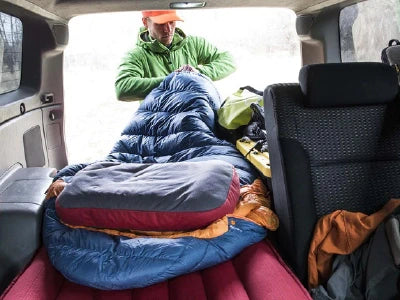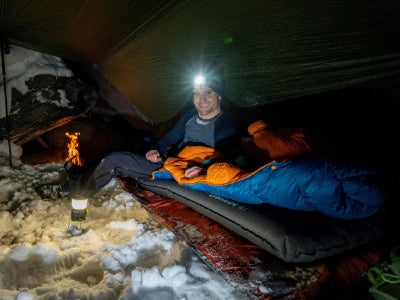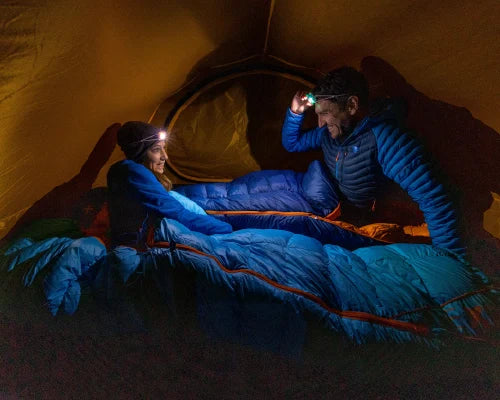
Down vs Synthetic Sleeping Bags: The Outdoor Experts' Opinion
Are you searching for the perfect sleeping bag and seeking advice on choosing between down and synthetic fill? Look no further! In this article, we'll share our expertise gathered from many outdoor experiences with different performance sleeping bags. When you finish this guide, you'll have the knowledge and confidence to choose between down and synthetic fill, ensuring you find the perfect match for your comfort and warmth needs.
In case you have urgency, here is what you will read in this article.
Table of Contents:
A Detailed Comparison
What's the superior choice: Down or Synthetic? A common misconception is that synthetic fibres are inherently inferior to down. However, this oversimplifies the matter.
While down sleeping bags certainly hold their appeal, synthetic fill sleeping bags have seen significant improvements in recent years, and both types can provide excellent outdoor experiences under various conditions. In this guide, we'll examine the key factors you should consider when choosing between the two.
Warmth to Weight Ratio
Contrary to common belief down isn't necessarily better than synthetic fill simply because it's warmer. Down fill is often lighter and more compressible for the same warmth as most synthetic fills. This means that, while many modern synthetic fill bags impress with their cold-temperature performance, down wins in terms of warmth-to-weight ratio.
For those planning long hikes with their sleeping bags or facing limited space in their backpacks, down-fill bags are advantageous for this reason.


A Detailed Comparison
What's the superior choice: Down or Synthetic? A common misconception is that synthetic fibres are inherently inferior to down. However, this oversimplifies the matter.
While down sleeping bags certainly hold their appeal, synthetic fill sleeping bags have seen significant improvements in recent years, and both types can provide excellent outdoor experiences under various conditions. In this guide, we'll examine the key factors you should consider when choosing between the two.


Warmth to Weight Ratio
Contrary to common belief down isn't necessarily better than synthetic fill simply because it's warmer. Down fill is often lighter and more compressible for the same warmth as most synthetic fills. This means that, while many modern synthetic fill bags impress with their cold-temperature performance, down wins in terms of warmth-to-weight ratio.
For those planning long hikes with their sleeping bags or facing limited space in their backpacks, down-fill bags are advantageous for this reason.

Water Repellency
It's a widespread concern that down sleeping bags may get ruined when exposed to water. While there is some truth to this, it doesn't tell the full story. When down is exposed to water or moist air, the plumes clump together, immediately reducing their loft and resultant insulation performance. Although this effect is not permanent, repeated water exposure can cause permanent damage over time.
On the other hand, synthetic fibres retain their loft better when wet and dry much faster than down. If your outdoor pursuits regularly take you through wet conditions, these characteristics might tip the scales in favour of a synthetic fill bag.
Do keep in mind that, while down is more sensitive to water than synthetic fibres, most manufacturers now treat their down with a durable water repellent (DWR) to increase moisture resistance, which fades over time. As such, you should revitalise this waterproofing at some stage using a waterproofing spray for down jackets or sleeping bags.
Resiliency of Materials
Down fill often outlasts synthetic because of their contrasting structural properties. Down fill's superior loft resilience comes from its unique three-dimensional structure. Specifically, each down cluster comprises myriad tiny filaments radiating from a central point. When compressed, these clusters are able to spring back to their original shape and volume. This is what contributes to down's renowned superior longevity.
Synthetic fibres, in contrast, are typically made from linear polyester strands that are crimped (or bent) to mimic down's loft. Over time, this crimp in synthetic fibres can flatten, causing them to lose loft and warmth.
In essence, synthetic materials have yet to quite catch up with the bounce-back abilities perfected over millions of years of avian evolution - and that's hardly surprising when you think about it! This distinction brings us back to our love for the natural world around us, reminding us of the beauty and complexity of nature - and offering yet another reason to cherish our time spent outdoors.
Pros and Cons: Summarised
| Factors to Consider | Down Sleeping Bags | Synthetic Sleeping Bags |
|---|---|---|
| Warmth to Weight Ratio | Excellent: Lighter and more compressible for the same warmth. Ideal for long hikes and limited backpack space. | Good: Improved compressibility and performance in cold temperatures, though generally less compressible than down. |
| Water Repellency | Sensitive to water, loses loft when wet. Treated with durable water repellent (DWR), but its effectiveness fades over time. | Better in wet conditions. Retains loft and dries faster than down. Good choice for damp environments. |
| Resiliency of Materials | Superior due to the three-dimensional structure of down clusters. Tends to last longer with proper care. | Tends to lose loft and warmth over time due to the flattening of crimped polyester strands. |
| Washing and Product Care | More care is needed. Sensitive to water, oils, and dirt. Requires specialised downwash. Proper drying is essential. | Easier to wash and care for. Dries faster and is less sensitive to water, oils, and dirt. |
| Price Considerations | Generally more expensive. Considered a long-term investment due to its durability. Ethical sourcing is a factor. | More budget-friendly. Good performance for the price. |
Pros and Cons: Summarised
Factors to Consider
Down Sleeping Bags
Synthetic S. Bags
Warmth to Weight Ratio
Excellent: Lighter and more compressible for the same warmth. Ideal for long hikes and limited backpack space.
Good: Improved compressibility and performance in cold temperatures, though generally less compressible than down.
Water Repellency
Sensitive to water, loses loft when wet. Treated with durable water repellent (DWR), but effectiveness fades over time.
Better in wet conditions. Retains loft and dries faster than down. Good choice for damp environments.
Resiliency of Materials
Superior due to the three-dimensional structure of down clusters. Tends to last longer with proper care.
Tends to lose loft and warmth over time due to the flattening of crimped polyester strands.
Washing and Product Care
More care is needed. Sensitive to water, oils, and dirt. Requires specialised downwash. Proper drying is essential.
Easier to wash and care for. Dries faster and is less sensitive to water, oils, and dirt.
Price Considerations
Generally more expensive. Considered a long-term investment due to its durability. Ethical sourcing is a factor. essential.
More budget-friendly. Good performance for the price.
Washing and Product Care
Down sleeping bags demand more care when washing than synthetic bags, but yes, you can wash your down sleeping bag in the machine!
As mentioned, down is more sensitive to water than synthetic fibres and therefore is more susceptible to damage during washing. The same is true for oils and dirt with down bags, which inevitably build up inside and are more detrimental to the insulation performance of down than synthetic fibres. As well as less chance for damage from water, synthetic fibres, therefore, have less need for frequent washing.

When it's time to wash your down sleeping bag, always use a specialised down wash designed to clean, restore water repellency, and preserve the fill such as Nikwax Down Proof Waterproofing Wash. Additionally, a great defence is to invest in a sleeping bag liner, which absorbs dirt and can be washed separately. Various liners can add significant warmth to your bag.
It is important to note that, especially for down bags, proper drying is essential to prevent clumping and potential damage to the fill. While synthetic sleeping bags are easier to care for, down sleeping bags can remain in excellent condition with the right care and attention.
Price Considerations
Price, naturally, is a significant factor to consider in the down versus synthetic debate.
Generally, down sleeping bags carry a heftier price tag than synthetic bags, largely stemming from the varied production methods involved. Although beginners and budget-conscious consumers might lean towards synthetic fill bags as they can be significantly cheaper, it's crucial to evaluate what you might need out of your bag later down the track. Hence, given the superior resilience and performance of down bags, you could save a lot of money by investing in a quality bag upfront.
If you're considering a down bag, looking for those with a Responsible Down Standard (RDS) certification is worthwhile. This ensures the down used is ethically sourced, meaning the birds were treated humanely. Recent innovations in sleeping bag fill technologies, which we'll explore in the later section, may influence your final decision.
Which is the right option for your adventure?
Choosing the perfect sleeping bag for your adventure boils down to balancing your personal needs, your environment, activity type, and budget:



Your Outdoor Experience
Seasoned Adventurers: Down sleeping bags, known for their longevity, compressibility, and high warmth-to-weight ratio, are ideal for challenging and regular outdoor expeditions.
Casual Campers or Beginners: Synthetic sleeping bags, affordable and easy to maintain, make a great choice for those new to camping or on infrequent adventures.

Your Environment
Coastal/Wet Regions: In humid and wet conditions, synthetic bags excel because they retain warmth even when damp.
Inland/Dry Regions: Down bags, with their superior insulation, are more suitable for cooler, drier climates.

Your Activity
Car Camping: If weight isn't an issue, opt for the comfort and budget-friendliness of synthetic bags.
Backpacking & Long Hikes: With their superior compressibility and lighter weight, down sleeping bags are invaluable when carrying your gear over long distances.

Your Budget
Cost-Conscious: Synthetic sleeping bags are more budget-friendly and offer reasonable performance.
Long-Term Investment: If you can stretch your budget, a high-quality down bag offers superior performance and longevity, proving cost-effective over time.

Which is better?
To summarise, down generally offers superior warmth-to-weight ratio, compressibility, and longevity, while synthetic provides better water resistance and is easier to care for.
Price-wise, down bags are more expensive; however, when purchasing a sleeping bag, you should carefully consider your personal needs, activities, and budget. Remember, whichever type of sleeping bag you choose, care and maintenance will go a long way in preserving its performance and prolonging its life.
If you have the resources and are committed to the proper upkeep of your gear, we advise investing in a down sleeping bag, as reflected in our curated collection. Whether you prefer down or synthetic, there's certainly a sleeping bag out there that's perfect for you. Adventure awaits, so let's help you find your ideal sleep companion!
K2 Base Camp’s Cutting Edge Sleeping Bag Range
As Queensland's premiere outdoor specialist store, we deliberately stock only the most technical and high-performance sleeping bags available. Top-tier brands like Mont and Exped continually push the boundaries, pioneering remarkable breakthroughs in synthetic and down materials for sleeping bags.
In this dynamic industry, long-standing synthetic fill fibres are steadily making way for more efficient, state-of-the-art replacements. One such progressive technology is Hollow Core insulation, enhancing thermal efficiency and heat retention. For instance, Mont's Evo Ultra Light sleeping bag employs these ingenious fibres. Their hollow centres trap more air than solid fibres, offering superior thermal efficiency. Moreover, the design significantly trims the weight and boosts compressibility, thanks to the reduced material in each fibre.
Mont's Zero Ultralight Down Sleeping Bag is another instance of innovation at its best, featuring hydrophobic Epic Thread across its entire range. This silicon-infused thread brilliantly curbs moisture-wicking along seams and within the shell, thereby ensuring the down remains dry and retains optimal warmth.
Mont and Exped shine in the market by also focussing on their sleeping bags' outer shell properties. Mont's Hydronaut XT range boasts a proprietary microporous waterproof liner, assuring unparalleled warmth and comfort surpassing that of coated fabrics. With a waterhead rating of 20,000mm, the material provides stellar moisture and wind protection and exceptional breathability, rated to expel 20L of water vapour per square metre per 24 hours. This results in drier down, greater loft and maximal warmth.
Exped's prowess in innovative outer shell production is evident with their patented STEALTH™ seam-welding technology. This unique method employs ultrasonic edge-joining and high-frequency radio welding to generate seams that are 50% stronger, 90% warmer, and half as thick as traditional seams. Exped also aims to develop sustainable products with less environmental impact by meeting OEKO TEX and myclimate certification standards. Since 1980's the firm practices a recycling program for its end of life down products to keep their lifecycle going.

RESPONSIBLE DOWN STANDARD
A voluntary global standard that ensures down is not sourced via live plucking, that birds are not force fed & that a birds welfare is always upheld. Both exped and Mont uses only RDS certified down.

HYDRONAUTE XT SHELL
Mont's Hydronaute XT fabric is completely waterproof, totally windproof & highly breathable.
Guaranteed to maintain greater warmth & comfort than coated fabrics, Hydronaute XT is the best protection for down sleeping bags & clothing in cold to extreme conditions.

OEKO TEX STANDARD
97% of materials EXPED uses in its products is certified to meet stringent standards for water and energy consumption, pollution control, and chemical safety. 100% of products are free of BPA and PFOA(C8), both harmful industrial chemicals.
K2 Base Camp’s Cutting Edge Sleeping Bag Range
As Queensland's premiere outdoor specialist store, we deliberately stock only the most technical and high-performance sleeping bags available. Top-tier brands like Mont and Exped continually push the boundaries, pioneering remarkable breakthroughs in synthetic and down materials for sleeping bags.
In this dynamic industry, long-standing synthetic fill fibres are steadily making way for more efficient, state-of-the-art replacements. One such progressive technology is Hollow Core insulation, enhancing thermal efficiency and heat retention. For instance, Mont's Evo Ultra Light sleeping bag employs these ingenious fibres. Their hollow centres trap more air than solid fibres, offering superior thermal efficiency. Moreover, the design significantly trims the weight and boosts compressibility, thanks to the reduced material in each fibre.

RESPONSIBLE DOWN STANDARD
A voluntary global standard that ensures down is not sourced via live plucking, that birds are not force fed & that a birds welfare is always upheld. Both exped and Mont uses only RDS certified down.

HYDRONAUTE XT SHELL
Mont's Hydronaute XT fabric is completely waterproof, totally windproof & highly breathable.
Guaranteed to maintain greater warmth & comfort than coated fabrics, Hydronaute XT is the best protection for down sleeping bags & clothing in cold to extreme conditions.

OEKO TEX STANDARD
97% of materials EXPED uses in its products is certified to meet stringent standards for water and energy consumption, pollution control, and chemical safety. 100% of products are free of BPA and PFOA(C8), both harmful industrial chemicals.
Mont's Zero Ultralight Down Sleeping Bag is another instance of innovation at its best, featuring hydrophobic Epic Thread across its entire range. This silicon-infused thread brilliantly curbs moisture-wicking along seams and within the shell, thereby ensuring the down remains dry and retains optimal warmth.
Mont and Exped shine in the market by also focussing on their sleeping bags' outer shell properties. Mont's Hydronaut XT range boasts a proprietary microporous waterproof liner, assuring unparalleled warmth and comfort surpassing that of coated fabrics. With a waterhead rating of 20,000mm, the material provides stellar moisture and wind protection and exceptional breathability, rated to expel 20L of water vapour per square metre per 24 hours. This results in drier down, greater loft and maximal warmth.
Exped's prowess in innovative outer shell production is evident with their patented STEALTH™ seam-welding technology. This unique method employs ultrasonic edge-joining and high-frequency radio welding to generate seams that are 50% stronger, 90% warmer, and half as thick as traditional seams. Exped also aims to develop sustainable products with less environmental impact by meeting OEKO TEX and myclimate certification standards. Since 1980's the firm practices a recycling program for its end of life down products to keep their lifecycle going.
Our Recommendations for the Best Sleeping Bag for Your Next Adventure
The Comfort 0°C is a roomy, feature-rich, extremely versatile mummy bag built for maximum comfort from late spring through early fall. The generous cut of the Comfort series at shoulders, hips, legs and feet increases freedom of movement while maintaining the thermal efficiency of a mummy bag.
The sculpted, easily adjusted Comfort Hood️ insulates the entire head and neck area in colder conditions but opens wide for warmer temperatures. A plush, adjustable down-filled draft collar reduces the loss of heat due to body movement and the resulting "bellows action" that can pump heat out of the hood. The collar also adds insulation around the neck, where heat loss is particularly common.
A zippered arm opening in the seam opposite the main zipper allows both arms free to hold a book, play cards or do chores without leaving the bag.
BlanketZip, Exped's zippered foot section, opens the foot end of the bag, which converts the Comfort into a camp parka for walking around camp in cool weather or, with the main zipper opened, into a blanket for one or two people warmer conditions.
All Exped sleeping bags from their trekking, basecamp and expedition series' can be zipped to each other and to most sleeping bags from other manufacturers.
Waterproof stuff sack and mesh storage duffle bag included.
-1 TO -7°C
A 3 to 4 season ultralight sleeping bag designed for minimum weight (only 850g!) & maximum versatility, the Helium 450 has proven popular with hikers in a range of climates from coastal walks to sub alpine elevations. The 450 allows temperature regulation with dual zippers & offers incredible warmth-to-weight thanks to 800+ loft down. Maximise your pack space with a compact, lightweight and versatile Helium 450 sleeping bag.
Ultralight shell fabric and high-loft down fill on the Helium bags mean higher performance for less weight. Durable 10 by 10 denier, 520 thread count Nylon weighing only 26g/m2 with a hot-rolled-cire treatment to prevent down leakage and increase durability. Premium 800+ loft white down fill with DWR Loft treatment adds greater resilience, higher loft and better warmth in damp conditions.
Set up the tent and wiggle into this warm, Lightweight, weather resistant and super tough synthetic sleeping bag from Exped. The LiteSyn +2˚C is a 2 season synthetic sleeping bag ideal for durability, humidity resistants and performance comfort when hiking, trekking, camping, backpacking or travelling in wild conditions.
Features:
- Synthetic fill makes the bag resistant to humidity
- Excellent warmth/weight ratios
- Tough and durable
- Easy to wash and dries quickly
- Lightweight and compact
- Summer bag without warmth collar
- Side baffles with Insotect technology
